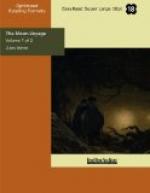As to caustic potash, it has a great affinity for carbonic acid mixed in air, and it is sufficient to shake it in order for it to seize upon the acid and form bicarbonate of potash. So much for the absorption of carbonic acid.
By combining these two methods they were certain of giving back to vitiated air all its life-giving qualities. The two chemists, Messrs. Reiset and Regnault, had made the experiment with success.
But it must be said the experiment had only been made in anima vili. Whatever its scientific accuracy might be, no one knew how man could bear it.
Such was the observation made at the meeting where this grave question was discussed. Michel Ardan meant to leave no doubt about the possibility of living by means of this artificial air, and he offered to make the trial before the departure.
But the honour of putting it to the proof was energetically claimed by J.T. Maston.
“As I am not going with you,” said the brave artilleryman, “the least I can do will be to live in the projectile for a week.”
It would have been ungracious to refuse him. His wish was complied with. A sufficient quantity of chlorate of potash and caustic potash was placed at his disposition, with provisions for a week; then having shaken hands with his friends, on the 12th of November at 6 a.m., after having expressly recommended them not to open his prison before the 20th at 6 p.m., he crept into the projectile, the iron plate of which was hermetically shut.
What happened during that week? It was impossible to ascertain. The thickness of the projectile’s walls prevented any interior noise from reaching the outside.
On the 20th of November, at six o’clock precisely, the plate was removed; the friends of J.T. Maston were rather uneasy. But they were promptly reassured by hearing a joyful voice shouting a formidable hurrah!
The secretary of the Gun Club appeared on the summit of the cone in a triumphant attitude.
He had grown fat!
CHAPTER XXIV.
THE TELESCOPE OF THE ROCKY MOUNTAINS.
On the 20th of October of the preceding year, after the subscription list was closed, the president of the Gun Club had credited the Cambridge Observatory with the sums necessary for the construction of a vast optical instrument. This telescope was to be powerful enough to render visible on the surface of the moon an object being at least nine feet wide.
There is an important difference between a field-glass and a telescope, which it is well to recall here. A field-glass is composed of a tube which carries at its upper extremity a convex glass called an object-glass, and at its lower extremity a second glass called ocular, to which the eye of the observer is applied. The rays from the luminous object traverse the first glass, and by refraction form an image upside down at its focus. This image is looked at with the ocular, which magnifies it. The tube of the field-glass is, therefore, closed at each extremity by the object and the ocular glasses.




